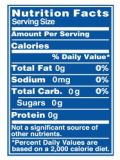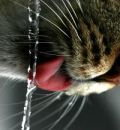Choosing the right cat food will ensure that your cat is healthy and happy
With so many types of cat food on the market today, it is not difficult to find the right food for your cat or kitten.
A cat needs a healthy, balanced diet on a daily basis to maintain good health.
Some of the things to consider when purchasing cat food is your cat or kitten's age, health and their lifestyle. (Is your cat active or a couch potato?)

Cats depend on meat and similar foods such as fish for the nutrients that they need to remain healthy.
A cat is called an "obligate carnivore" - which means that it cannot survive on a low-protein diet. In other words, a cat needs meat to stay healthy.
The right nutrients

What is important to remember is that your cat needs the right balance of nutrients, too much can cause as many problems as too little.
Commercial cat food has added nutrients which is a better option as it is difficult for you to make sure that a home-cooked meal contains the right balance of nutrients.
Cats have no nutritional use for carbohydrates even though they are able to digest and metabolize it. A cat's high protein diet gives it all the energy needed.
A cat's central nervous system needs vitamins of the B group and vitamin A to keep the body's cells working properly. For healthy bones and teeth, vitamin D and phosphorus is essential. Vitamin E helps to prevent cell damage.
Grass contains high levels of folic acid and cats will eat grass to induce vomiting, helping them to rid their systems of parasites, hairballs or a digestive upset.

Pet shops often sell containers with "cat grass" that you can grow indoors for your cat to munch on.
This is a good idea as you know that there are no pesticides or weed killers on this grass that can harm your cat.
Protein supplies essential amino acids that a cat's body cannot produce on its own.
Taurine is one of the most important amino acids, a deficiency can cause blindness, heart disease and infertility in cats.
The Association of American Feed Control Officials (AAFCO) has made it compulsory to have a minimum of 0.1% taurine in dry food and 0.2% in wet food.
Essential fatty acids are important to maintain overall body health. Fiber is essential in a cat's diet to prevent constipation, especially in older cats. Commercial cat food contains added fiber.
If your cat is on a commercially prepared, well balanced diet, food supplements should not be necessary. As mentioned, too much nutrients can cause health issues.
Types of Food
Wet food (pouch or canned)

Cats usually prefer wet cat food and it is available in a wide range of flavors and textures. Wet food has a high water content.
Semi-moist

This kind of cat food contains less water than the wet food and often contains vegetable proteins.
Dry food

Dry food has minimal water so plenty fresh water should be available for your cat. Because of the texture, dry food helps to keep tartar from building up on your cat's teeth.
How much to feed your cat
Following the manufacturer's guide on the packaging is a good idea as to what weight of food to feed per day.
Split this weight over as many meals as your cat prefers.
When to feed your cat
Most cats like to eat twice a day (morning and evening), whilst other cats like to eat their daily allowance at once.
Wet food goes off very quickly, so ensure that it is not left out all day. Dry food can be left out all day for your cat to nibble on.
Water

Water must be available 24/7 for your cat. If your cat does not like hard water (a high concentrate of mineral salts) try using filtered water.
Avoid bottled water due to the high mineral content.
Food and water bowls
Food and water bowls should be shallow enough so that your cat can easily eat and drink.
Stainless steel, ceramic or plastic bowls with non-slip bases are the best.
Keep the bowls spotless to prevent germs from building up. Do not use dish washing detergents as the smell can taint the bowls, causing your cat to stop using it.
Rinse out the bowl with hot water and a teaspoon of salt.
Home-cooked food
It is better to stick to a commercially prepared food as it contains the right balance of nutrients. However, most cats will enjoy a treat of fish and poultry.
Make sure that the cooked food has cooled down before feeding.
You can combine commercial cat food with home-cooked food so that your cat does not become bored or fussy with its food.
Cats and chocolate
Do not feed your cat chocolate as even the tiniest amount can be highly toxic and even deadly.
Chocolate contains caffeine and theobromine, which can affect the heart muscle and the central nervous system.
Cats and milk
Cats are lactose intolerant and giving a cat milk or cream can cause digestive upsets. Commercial cat foods contain the necessary calcium.
Feeding Guide
|
Kittens |
Kittens stop drinking their mother’s milk when they are 8 weeks old. They then start on solid food and should be fed only commercial kitten food that is easy to digest and nutritionally balanced. |
|
Weaning to 12 weeks |
Five small meals a day of 25g each. |
|
12 to 20 weeks |
Four meals a day. |
|
20 to 30 weeks |
Three meals a day. |
|
30 weeks to 12 months |
The cat is now considered a juvenile or adolescent. Gradually reduce meals to twice a day. |
|
12 months to 8 years |
The cat is now considered an adult. One or two meals a day, as per the cat’s preference. |
|
8 years and older |
The cat is now considered elderly. One or two meals a day, depending on your cat’s health and condition. |
- Always provide fresh drinking water.
- Keep food and water bowls far away from the litter box.
- Do not give cow’s milk as cats are lactose-intolerant.
- Food should be at room temperature.
- Make sure that bowls are kept spotlessly clean.
- Don’t use commercial dish washing detergents to clean bowls.
Use a teaspoon of salt and hot water, rinsing thoroughly.
- Never give your cat chocolate.
- Don’t keep canned foods for more than 24 hours, even if stored in the fridge.
- Never give your cat spicy food or food that has alcohol added.
- Don’t disturb your cat whilst he is eating. Teach children the same.
- Remove bones from home-made food to prevent choking.
- Gradually change the cat’s diet if required.
- Don’t leave wet or semi-moist food out all day.
- Cats like to drag food out of the bowl to eat it on the floor. Put a place mat under the bowl.
- Feedings must occur in the same place every time.
- Consult your vet should there be any signs that your cat has difficulty eating or drinking.







